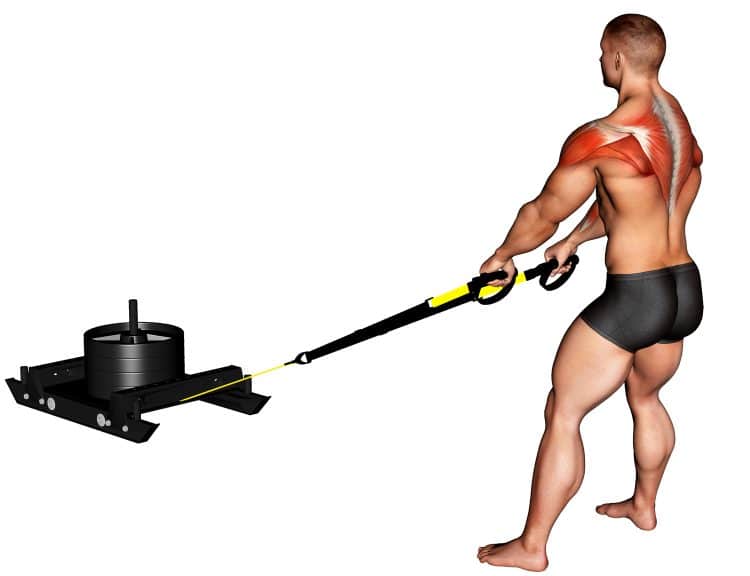Sled pull aka sled drag is one of the best functional exercises.
But what are functional exercises, you ask?
These exercises help build strength that can be used in real-life situations, which is something you cannot say for exercises like the pec deck fly. Think of it this way – while isolation lifts help improve muscular vanity, compound lifts make you strong like a bear.
Pulling big weights has been a way for people to show off strength since time immemorial. Sleds pushing/pulling is a badass exercise that has gained massive popularity. They are featured in commercials, motivational training videos, and a gazillion Instagram reels.
We have witnessed people pull cars, trucks, trains, and heck, even airplanes to set world records. To be honest, these pulling contests are indeed quite interesting.
Watch a man pull a big enough weight, and you almost see his soul leaving his body through his mouth. It sounds weird, agreed, but it is a sight to behold.
Level Up Your Fitness: Join our 💪 strong community in Fitness Volt Newsletter. Get daily inspiration, expert-backed workouts, nutrition tips, the latest in strength sports, and the support you need to reach your goals. Subscribe for free!
It does not matter if your goal is to pull a mountain or win the world’s strongest man competition, the sled pull will probably be a big part of your training routine.
The simplicity and effectiveness of the sled drag make it a great exercise for people with any experience level, background, or goal. If you want to get stronger, you better be doing some sled pulling.
Sled Pull Muscles Worked
The sled pull is a full-body strength-based cardio exercise. The exercise can help strengthen your quads, hamstrings, glutes, lower back, and calf muscles in one movement.
The versatility of the sled pull allows you to perform several variations with the same equipment. Some of these alternative exercises can also train your arms and upper back, muscles that are otherwise secondary in the orthodox variation of the exercise.
Sled Pull Benefits
Sled pulling is a great exercise no matter your goal. You could do this exercise for building strength, muscle hypertrophy, and metabolic conditioning. Sled pull can also be performed while recovering from an injury. Here are a few benefits of the sled pull:
1. A Great Exercise For Building Lower Body Strength, Power, and Size
Sled pulling and pushing can help develop strength in your glutes, calves, hamstrings, quads, and core.
Sled pull is a great tool for runners, sprinters, or any athlete looking to improve their explosive legs power. Not only does this exercise build muscle strength, but it can also help build a jacked pair of wheels.
Sled pulling for durations of 60-90 seconds can work muscular endurance and hypertrophy, setting the stage for adding mass to your legs.
2. Can Be Done By People at Any Experience Level
Sled pulling is one of the most basic exercises an individual can perform. Since it requires minimal equipment, it is a great fit for commercial and home gyms alike.
Changing your training style can help you use the sled for different goals. You could use it to improve your posterior chain or upper body strength and endurance.
3. Low Chances of Injury
Sled work does not require complex movement patterns that Olympic lifts or even power lifts demand. As a result, the risk of injury from sled work is relatively low.
The exercise allows lifters to more or less set how much stress they put on their bodies.
4. Improves Aerobic and Anaerobic Conditioning
The exercise engages your legs, glutes, core, back, shoulders with the very first step you take. It is a highly demanding exercise that is great for burning calories.
You can even turn up the heat by several notches while performing the exercise by changing a few variables like the weight on the sled, your speed, or time duration to improve your conditioning.
5. Suitable For People Recovering From an Injury
If you are recovering from an injury, pulling the sled is a great training option as it mostly consists of concentric muscle action. The lack of eccentric contractions results in more oxygen-rich blood being pumped into your muscles.
Also, eccentric (lengthening) motions are mainly responsible for causing DOMS (delay onset muscle soreness). Only focusing on concentric-motion dominant exercises can help you recover faster.
6. Improves Acceleration & Speed
While using a harness on the sled, runners need to increase the amount of force they use to take off. Performing this exercise over time can aid in improving your acceleration and speed.
How To Do The Sled Pull
This is how to perform the sled pull aka sled drag:
- Add the appropriate amount of weight plates to the sled.
- Attach a shoulder harness or specialized vest to the sled.
- Stand facing away with the sled positioned behind you.
- If you are using upper-body straps with handles or loop attachments, pull them over your shoulders or under your armpits.
- Get in position by placing one foot in front of the other.
- Lean forward and stay as low as possible as you drive with your legs and propel forward through your hips and legs.
- Walk for at least 15-25 meters per set.
Sled Pull Tips
Here are a few tips that can help you make the most of the sled drag:
Level Up Your Fitness: Join our 💪 strong community in Fitness Volt Newsletter. Get daily inspiration, expert-backed workouts, nutrition tips, the latest in strength sports, and the support you need to reach your goals. Subscribe for free!
- Before performing the exercise, make sure you have warmed up your lower body with some light cardio. Heavy sled drags can increase your chances of a quad or hamstring injury if done without a thorough warm-up.
- After you are done with your warm-up, spend at least five minutes stretching your legs.
- If you have never done sled pulls before, you would be better off starting with a light weight until you nail down the perfect form.
- Staying on your toes while performing the exercise will recruit more of your quadriceps.
- On the other hand, if you want to focus on your hams or glutes, then reach your arms and hands forward and plant your heel first while ‘pulling’ yourself forward with your heels.
- Using knee straps can help elevate excessive stress from your joints. They are a must for people recovering from related lower-body injuries. Similarly, wearing a weightlifting belt can also keep off unnecessary tension from your lower back.
- Pro tip: Always keep moving while performing sled drags. Momentum is your friend while performing the exercise. Stopping and starting often makes the movement harder.
Check Out: Ben Patrick ‘KneesOverToesGuy’ and Joe Rogan Discuss The Efficacy of Sled-Pulling For Knee Health
How To Sled Pull For Speed
Sled dragging can help you achieve several objectives. Here is how to use a sled pull to improve your speed:
- Load the sled with 25% of your maximum load.
- Get in position, and start dragging the sled as fast as you can.
- Pull for 10-20 yards.
- Rest for 30-60 seconds.
- Repeat 4-6 times, resting not more than 30-60 seconds between sets.
How To Sled Pull For Power
If your primary objective is to build power, you should be using more weight compared to what you used while sled pulling for speed.
- Load the sled with 70% of your maximum load. If you are not sure about the maximum weight you can pull, go with a weight that is 70% of your body weight.
- You might need to change this weight after assessing your performance on the first set.
- Engage your core and start pulling the sled forward as fast as possible.
- Push for 10-25 yards.
- Rest for 30-60 seconds.
- Repeat 4-6 times, resting not more than 30-60 seconds between sets.
How To Sled Pull for Endurance
While sled dragging for endurance, you do not have a distance goal. You will be pulling for a time goal.
- Load the sled with 25% of your maximum load.
- Engage your core and start pulling the sled forward.
- Drag the sled for at least one minute.
- You do not need to drag as fast as you can since this is not for speed or power.
- Rest for 30-60 seconds.
- Repeat 8-10 times. Rest for 30-seconds between sets.
Check Out: Ex-NFL Linebacker James Harrison Celebrates 42nd Birthday By Pushing 1,960lb Sled
Sled Pull Variations
The versatility of the sled pull allows you to use the exercise to target different muscle groups. Here are some of the most effective variations and alternatives of the sled drag:
1. Backward Sled Pull
In this exercise, you will be facing the sled and walking backward. The backward sled pull puts a greater emphasis on your back, glutes, and hamstrings.
Steps:
- Load an appropriate weight onto a sled and attach a shoulder or hand harness to it.
- While holding the harness with an overhand grip, walk back until the harness is taut.
- Lean back slightly and start to walk backward.
- Maintain a constant pace throughout the exercise.
2. Bear Crawl
The bear crawl is one of the advanced sled drag exercises. It requires you to pull the sled while you are on all fours. You will be using a shoulder harness or a specialized sled drag vest for this exercise.
Steps:
- Load an appropriate weight onto a sled and attach a shoulder harness or a vest to it.
- Face away from the sled and walk until the harness is taut.
- Get on all fours. Your hands should be placed flat on the floor, back flat and knees bent.
- Your feet should be hip-distance apart with heels off the floor. Place one foot in front of the other.
- Begin by driving with legs, alternating left, and right. Use your hands to maintain balance and to help pull.
3. Step-Over Sled Pull
This variation of the sled drag will set your core on fire. If you want to build a shredded midriff, the step-over sled pull should be part of your ab training regimen.
Steps:
- Load an appropriate weight onto a sled and attach a double handle/band.
- Step away from the sled so that the harness is taut.
- Face sideways so that your body is perpendicular to the sled.
- Adjust the bands so that the handle on the side closer to the sled is shorter compared to the other side.
- Retract your shoulders and lean forward slightly to get in the starting position.
- Lift your back foot and place it in front of the other and walk sideways.
- Repeat on the other side.
- Make sure your shoulders are static and locked throughout the exercise to properly engage your core.
4. Sled Pull Through
The sled pull-through engages your shoulders and arms as well.
Steps:
- Load an appropriate weight onto a sled and attach a double handle/band.
- Stand with a wider than shoulder-width stance with the band between your legs.
- Walk forward so that your hands go down between your legs.
- Bend over at your hips and go down into a partial squat.
- Begin the exercise by pulling weight up with your arms, while at the same time thrusting forward with your hips and legs.
- Walk forward and repeat.
5. Overhead Sled Pull
Overhead sled drag is similar to the normal sled drag with the only difference being that you will be holding the handles over your head.
Steps:
- Load an appropriate weight onto a sled.
- Attach the shoulder harness or handles to the sled.
- Stand facing away with the sled positioned behind you.
- Walk forward until the bands are taut.
- Extend your arms overhead while maintaining a slight bend in your elbows.
- Bend forward slightly and start walking.
6. Sled Row
Sled row works your back and is a great exercise for building explosive back strength.
Steps:
- Load an appropriate weight onto a sled.
- Facing the sled, pull the straps taut with straight arms.
- Slightly bend your knees and maintain a straight spine as you pull the straps in a row movement (similar to how you would on a low-cable row machine).
- Once you complete a row, move back a few steps until the straps are taut and row again.
Another popular sled pull variation includes pulling the sled using a rope.
Steps:
- Load an appropriate weight onto a sled.
- Attach a rope to the sled, grab them with an overhand grip and walk back until the rope is taut.
- Get into a squatting stance with your knees bent, your feet shoulder-width apart, and your back upright.
- Start pulling the sled towards you one arm at a time until the sled is up close to you.
- Push the sled back to its starting position.
- Repeat.
Next Read: How To Build Muscle And Strength With A Sled
Wrapping Up
Sled pull is a functional exercise that can be used for different objectives by changing the amount of weight and exercise time duration. It should be a part of your training regimen, especially if you want to improve your overall fitness.
The sled drag is also a great exercise to help your muscles recover faster or if you are trying to work around an injury. To sum it up, you do not have a reason to skip the sled pulls. So, put on the harness and get going.
Interested in measuring your progress? Check out our strength standards for Squat.










